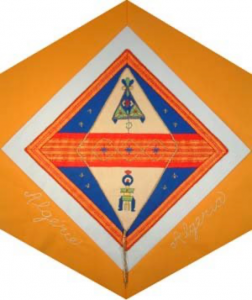Algeria

The Block
The eight-pointed star (known as Algerian eye stitch, star stitch, or star eyelet stitch) is one of the most common motifs used in Algerian needlework. It is believed to have protective powers. On this block, Aïcha Bourouh combined several different elements of typical Algerian craft work. The design is worked in gold filament around a central diamond (a common shape found in rug patterns), and in blue thread across the woven band of material separating the diamond into two sections.
Each section of the diamond features a hand-embroidered representation of Algerian jewellery: at the top a fibule (pin) used by women in the Kabylia region to fasten their clothing, and at the bottom, a pendant of the Hoggar region symbolizing the nomadic Tuareg men. These pendants, sometimes labelled ‘’Tuareg crosses’’, come in many shapes, but always include a diamond shape pointing upwards to a circle. The Tuareg are known as ‘the blue people’ because the taquelmust (veil) worn by males of the tribe is dyed with indigo and stains their skin. Both the diamond and central Algerian eye stitches are outlined in a fine gold braid, symbolic of the gold-work typically incorporated into Algerian garments. The piece is bordered in red and gold fabric like that traditionally worn by Kabylia women.
Cultural Profile
Algeria is located in an area of northwest Africa known as the Maghreb (sunset). As the second-largest country in Africa and the tenth-largest in the world, it is a nation almost twice the size of Québec. Algeria is over 80 percent desert, dominated by the vast expanse of the Sahara that covers 9 million square kilometres of Africa (Canada, in comparison, covers 9.9 million square kilometres). Algeria’s major ethnic groups are Arab and Berber (also known as the Amazigh) or Kabyle. The official language is Arabic, although most Algerians are bilingual or multilingual, speaking Arabic, French and one of several Berber dialects.
Algeria’s rich architectural legacy includes Roman ruins, Arab mosques decorated with mosaics, Turkish palaces and European-style buildings. The capital, Algiers, is often called Algiers the White due to its buildings which gleam white in the morning light and overlook the Mediterranean.
National crafts often incorporate Arab, Spanish, Turkish or European influences to the indigenous techniques and patterns — hand-woven rugs made of wool or goat hair, inlaid or painted furniture such as the colourful sendouk l’aroussa chest that contained a bride’s trousseau, earthenware, pottery, shoes, saddles, bags and belts made of camel leather, silver jewelry made by the Tuaregs and Kabyle jewelry adorned with corals.
Algeria’s musical heritage is also rich, reflecting the country’s many influences. The simple and rhythmic sounds of rai (pronounced ‘rye’) blend Spanish, Moroccan and Algerian music. Rai, long considered the music of the younger generation, was frowned upon for being too liberal. This resulted in many rai singers moving to France, where the genre is very popular. The more traditional bedoui (haunting desert music) consists of long poems sung a capella or accompanied by flutes and drums. Chaabi (folk music), a blend of Algerian and Andalusian music, uses mandolins, violons, pianos and percussion. The genre is also well-known internationally through Rachid Taha’s famous rendition of Ya Rayah, a song written by Dahmane El Harrachi .
Once a French colony, Algeria still has close ties to France where many Algerians emigrated in the last century. Their impact on French culture is tremendous. Famous people such as Yves St-Laurent, Alfred Camus, Isabelle Adjani, Bernard-Henri Lévy or Zinedine Zidane, all household names in France, are of Algerian ancestry.
Some Algerians have also been coming to Canada since 1946, often settling in Québec because of their French language. They came for social and economic reasons, but more recently many more have immigrated because of civil war. According to the 2011 census, there were over 49,000 Algerians in Canada.
Sponsor: Knights of Columbus #11243, St. Mary’s Parish, Williamstown
